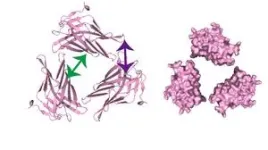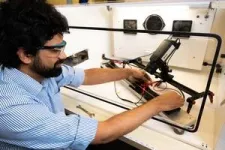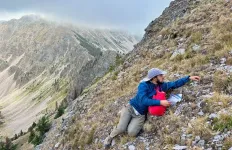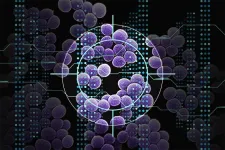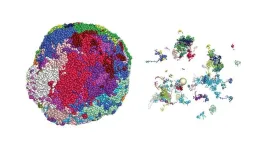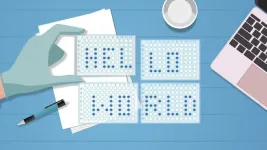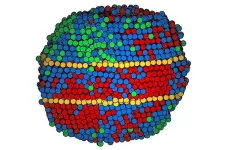One small material, one giant leap for life on Mars: Sussex research takes us a step closer to sustaining human life on the red planet
Using ‘waste’ product from recent NASA research, scientists create transformative nanomaterials with potential for clean energy production
2023-12-20
(Press-News.org) A mineral found on the surface of Mars offers potential to create sustainable energy
Uses ‘waste’ product from recent NASA research to create transformative nanomaterials
Findings could play role in shaping sustainable habitation on the red planet – and clean energy production back home
Researchers at the University of Sussex have discovered the transformative potential of Martian nanomaterials, potentially opening the door to sustainable habitation on the red planet.
Using resources and techniques currently applied on the International Space Station and by NASA, Dr Conor Boland, a Lecturer in Materials Physics at the University of Sussex, led a research group that investigated the potential of nanomaterials – incredibly tiny components thousands of times smaller than a human hair – for clean energy production and building materials on Mars.
Taking what was considered a waste product by NASA and applying only sustainable production methods, including water-based chemistry and low-energy processes, the researchers have successfully identified electrical properties within gypsum nanomaterials - opening the door to potential clean energy and sustainable technology production on Mars.
Dr Conor Boland, said:
“This study shows that the potential is quite literally out of this world for nanomaterials. Our study builds off recent research performed by NASA and takes what was considered waste, essentially lumps of rock, and turns it into transformative nanomaterials for a range of applications from creating clean hydrogen fuel to developing an electronic device similar to a transistor, to creating an additive to textiles to increase their robustness.
“This opens avenues for sustainable technology – and building – on Mars but also highlights the broader potential for eco-friendly breakthroughs here on Earth.”
To make the breakthrough the researchers used NASA's innovative method for extracting water from Martian gypsum, which is dehydrated by the agency to get water for human consumption. This produces a byproduct called anhydrite—considered waste material by NASA, but now shown to be hugely valuable.
The Sussex researchers processed anhydrite into nanobelts – essentially tagliatelle-shaped materials – demonstrating their potential to provide clean energy and sustainable electronics. Furthermore, at every step of their process, water could be continuously collected and recycled.
Dr Boland added:
“We are optimistic of the feasibility of this process on Mars, as it requires only naturally occurring materials – everything we used could, in theory, be replicated on the red planet. Arguably this is the most important goal in making the Martian colony sustainable from the outset.”
While full-scale electronics production may be impractical on Mars due to the lack of clean rooms and sterile conditions, the anhydrite nanobelts hold promise for clean energy production on Earth, and could, later down the line, still have a profound effect on sustainable energy production on Mars.
END
ELSE PRESS RELEASES FROM THIS DATE:
2023-12-20
Three winners have been selected in the 2023 Faces of Biology Photo Contest, sponsored by the American Institute of Biological Sciences (AIBS) and the Society for Integrative and Comparative Biology (SICB).
“Photography is an effective tool to help communicate the process of scientific research,” said Scott Glisson, CEO of AIBS. “This contest provides a visual forum for expression, inspiration, and technical skill that can have a positive impact on how the public views research and science.
The competition showcases, in a personal way, biological research in its many forms and settings. With the images, we ...
2023-12-20
CAMBRIDGE, MA – Using a type of artificial intelligence known as deep learning, MIT researchers have discovered a class of compounds that can kill a drug-resistant bacterium that causes more than 10,000 deaths in the United States every year.
In a study appearing today in Nature, the researchers showed that these compounds could kill methicillin-resistant Staphylococcus aureus (MRSA) grown in a lab dish and in two mouse models of MRSA infection. The compounds also show very low toxicity against human cells, making them particularly good drug candidates.
A key innovation of the new study is that the researchers were also able to figure out ...
2023-12-20
The mammalian nose is a work of evolutionary art. Its millions of nerve cells, each tailored with just one of thousands of specific odor-chemical receptors encoded in the genome, can collectively distinguish a trillion distinct scents. Those sensations, in turn, inform many behaviors, from assessing food options to discerning friends from foes to sparking memories.
Today, in the journal Nature, a research team led by scientists at Columbia’s Zuckerman Institute describes a previously undetected mechanism in mice—starring the genetic molecule RNA—that could explain how each sensory cell, or neuron, in mammalian noses becomes tailored to detect a specific ...
2023-12-20
About The Study: Compared with prior decades, the number of new dermatologic drug approvals by the Food and Drug Administration (FDA) increased between 2012 and 2022. Nearly half of these drugs were considered first in class or first in indication, and several were deemed clinically useful or to have high added therapeutic benefit by health technology assessment organizations in Germany, Canada, or France.
Authors: Ravi Gupta, M.D., M.S.H.P., of the Johns Hopkins University School of Medicine ...
2023-12-20
Taking inspiration from the human brain, researchers have developed a new synaptic transistor capable of higher-level thinking.
Designed by researchers at Northwestern University, Boston College and the Massachusetts Institute of Technology (MIT), the device simultaneously processes and stores information just like the human brain. In new experiments, the researchers demonstrated that the transistor goes beyond simple machine-learning tasks to categorize data and is capable of performing associative learning.
Although previous studies have leveraged similar strategies to develop brain-like computing devices, those transistors cannot function outside cryogenic temperatures. The new ...
2023-12-20
About The Study: This pilot pragmatic clinical trial included 243 homebound older adults with self- or proxy-reported dementia found a lower although nonsignificant likelihood of nursing home placement among those receiving daily-delivered meals compared with those receiving drop-shipped frozen meals. While this study was not powered to detect meaningful, statistically significant differences in nursing home placement, its feasibility and initial results warrant exploration in an adequately powered trial.
Authors: Kali S. Thomas, Ph.D., of the Brown University School of Public Health in Providence, Rhode Island, is the corresponding author.
To access the embargoed ...
2023-12-20
The human brain continues to be built after we are born for far longer than previously recognized, suggests research by Shawn Sorrells, assistant professor of neuroscience in the Kenneth P. Dietrich School of Arts and Sciences. Sorrells’s research on postnatal brain development, published today inthe journal Nature, shines light on fundamental processes that contribute to the development of important brain functions, such as learning, memory and spatial navigation.
The new research suggests that a subset of inhibitory neurons within the entorhinal cortex, or EC -- an area of the brain essential for forming memories -- continue ...
2023-12-20
In less time than it will take you to read this article, an artificial intelligence-driven system was able to autonomously learn about certain Nobel Prize-winning chemical reactions and design a successful laboratory procedure to make them. The AI did all that in just a few minutes — and nailed it on the first try.
"This is the first time that a non-organic intelligence planned, designed and executed this complex reaction that was invented by humans," says Carnegie Mellon University chemist and ...
2023-12-20
Alloys, which are materials such as steel that are made by combining two or more metallic elements, are among the underpinnings of contemporary life. They are essential for buildings, transportation, appliances and tools — including, very likely, the device you are using to read this story. In applying alloys, engineers have faced an age-old trade-off common in most materials: Alloys that are hard tend to be brittle and break under strain, while those that are flexible under strain tend to dent easily.
Possibilities for sidestepping that trade-off arose about 20 years ago, when researchers first developed medium- and high-entropy alloys, stable materials that combine ...
2023-12-20
Scientists have discovered one of the first new classes of antibiotics identified in the past 60 years, and the first discovered leveraging an AI-powered platform built around explainable deep learning.
Published in Nature today, the peer-reviewed paper, entitled “Discovery of a structural class of antibiotics with explainable deep learning,” was co-authored by a team of 21 researchers, led by Felix Wong, Ph.D., co-founder of Integrated Biosciences, and James J. Collins, Ph.D., Termeer Professor of Medical Engineering ...
LAST 30 PRESS RELEASES:
[Press-News.org] One small material, one giant leap for life on Mars: Sussex research takes us a step closer to sustaining human life on the red planet
Using ‘waste’ product from recent NASA research, scientists create transformative nanomaterials with potential for clean energy production

